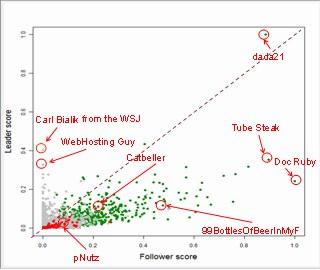Date:
 Text mining and Network mining as analytic approaches are by now becoming more common for revealing new insights in social media data. In text mining, the emphasis is on translating the textual data into sentiment in a carefully controlled process that places the emphasis on words and expressions within a given context. However, the information about the actual creator of the text, the sentiment expressed in it, and the counts and numbers of readers and responders cannot reveal the relevance of that person with respect to all others in that community, nor can it reveal the relative interactions between that person and others and how they relate to each other.
Text mining and Network mining as analytic approaches are by now becoming more common for revealing new insights in social media data. In text mining, the emphasis is on translating the textual data into sentiment in a carefully controlled process that places the emphasis on words and expressions within a given context. However, the information about the actual creator of the text, the sentiment expressed in it, and the counts and numbers of readers and responders cannot reveal the relevance of that person with respect to all others in that community, nor can it reveal the relative interactions between that person and others and how they relate to each other.
Network mining, on the other hand, does a very good job of identifying how individuals interact with each other. It does not rely on a categorical captured "thumbs up" or "star rating" of individuals to rate the importance of a person, but rather identifies those people of influence and those that are followers through physical nodes and connectors. However it cannot show sentiment.
 To date, each technique is usually done in isolation from the other, let alone any other predictive analytics techniques. A major European Telco used KNIME to combine both text mining and network analysis on their social media presence. While those results cannot be released, the KNIME team was able to duplicate the techniques on publicly available data sets.
To date, each technique is usually done in isolation from the other, let alone any other predictive analytics techniques. A major European Telco used KNIME to combine both text mining and network analysis on their social media presence. While those results cannot be released, the KNIME team was able to duplicate the techniques on publicly available data sets.
Taking advantage of having both network mining and text processing available within the KNIME environment allowed combining the results from the sentiment analysis with the results from the network analysis in order to position each user inside his/her community in terms of influence (leaders vs. followers) and sentiment (positive, neutral, and negative users). One example is shown here. The figure shows a scatterplot of the leader vs. follower score for all users belonging to the largest component. The X axis represents the follower score based on the hub weight whereas the Y axis represents the leader score based on the authority weight. For more information, see http://knime.org/socialmediawhitepaper
These techniques are now documented in a white paper along with a series of workflows and data that can be downloaded and used with open source KNIME at www.KNIME.com
